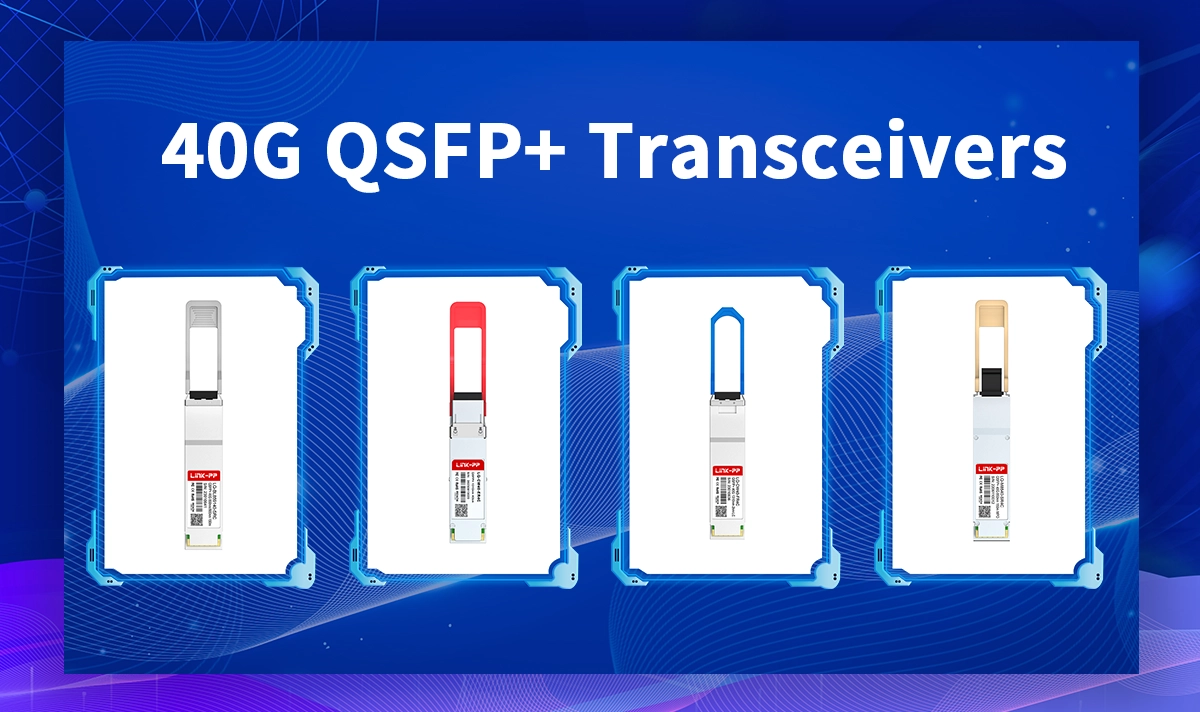
Overview: Navigating the purchase of 40G QSFP+ transceivers requires understanding key technical specifications, compatibility factors, and value propositions. This comprehensive guide demystifies the selection process, covering standards like 40GBASE-SR4 and LR4, critical factors such as distance requirements and MSA compliance, strategies for overcoming compatibility challenges, and the benefits of choosing reliable brands like LINK-PP. Learn how to optimize performance and cost-effectiveness for your 40G network infrastructure, including deployment best practices and answers to common FAQs.
➣ Understanding 40G QSFP+ Transceiver Fundamentals
40G QSFP+ (Quad Small Form-factor Pluggable Plus) transceivers remain vital for enterprise data centers, high-performance computing (HPC), and service provider networks requiring cost-effective 40 Gigabit Ethernet (40GbE) or 16G/32G Fibre Channel connectivity. These compact, hot-pluggable optical modules offer a significant density advantage over older form factors like SFP+, packing four 10G lanes into a single interface. The 40G standard, defined by IEEE 802.3ba, primarily utilizes parallel optics or Coarse Wavelength Division Multiplexing (CWDM) technologies.
Key QSFP+ MSA (Multi-Source Agreement) standards ensure mechanical and electrical interoperability between different vendors' modules and host equipment (switches, routers, NICs). Common 40G standards include:
40GBASE-SR4: Short Reach using OM3/OM4 multimode fiber (MMF), up to 100m/150m.
40GBASE-eSR4: Extended Short Reach, up to 300m/400m on OM3/OM4.
40GBASE-FR4: Up to 2km transmission on single mode fiber
40GBASE-LR4: Long Reach using single-mode fiber (SMF), up to 10km.
40GBASE-ER4: 4 CWDM lanes MUX/DEMUX design, up to 40km transmission.
➣ Key Selection Criteria for Your 40G QSFP+ Purchase
Choosing the right 40G QSFP+ transceiver involves evaluating several critical factors beyond just speed:
Application & Distance: What is the link length? What type of fiber is installed (MMF OM3/OM4 or SMF)?
Fiber Type Compatibility:
Multimode Fiber (OM3/OM4): Used with SR4 and eSR4 optics for intra-rack, intra-data center connections.
Single-mode Fiber (OS2): Required for LR4 optics for longer distances between buildings or across campuses.
Transceiver Type & Standard: Match the standard (SR4, LR4, eSR4, ER4) precisely to your distance and fiber type.
Wavelength: LR4 uses four CWDM lanes (1271nm, 1291nm, 1311nm, 1331nm). SR4/eSR4 use 850nm VCSEL arrays.
DOM Support: Digital Optical Monitoring provides real-time diagnostics (Tx/Rx power, temperature, voltage), crucial for proactive network management and troubleshooting.
Operating Temperature Range: Commercial (0°C to 70°C) or Extended (-40°C to 85°C). Choose based on deployment environment (e.g., industrial settings need extended).
Table: Common 40G QSFP+ Transceiver Types Comparison
Transceiver Type | Standard | Media | Max Distance | Typical Use Case | Wavelength |
|---|---|---|---|---|---|
SR4 | 40GBASE-SR4 | MMF (OM3/OM4) | 100m / 150m | Intra-Rack, Short DC Links | 850nm (4 lanes) |
eSR4 | 40GBASE-eSR4 | MMF (OM3/OM4) | 300m / 400m | Extended Intra-DC Links | 850nm (4 lanes) |
LR4 | 40GBASE-LR4 | SMF (OS2) | 10km | Inter-Building, Campus Links | CWDM (4 lanes) |
ER4 | 40GBASE-ER4 | SMF | Up to 40km | 40GBASE-ER4 Ethernet Links | CWDM (4 lanes) |
FR4 | 40GBASE-FR4 | SMF | 2km | Data Center Interconnect, 40G Campus Links | CWDM (4 lanes) |
➣ Navigating Compatibility & MSA Standards
Compatibility is arguably the biggest challenge when sourcing 40G QSFP+ optics. While the MSA defines the physical form factor and basic electrical interfaces, host equipment manufacturers (OEMs like Cisco, Juniper, Arista, HPE) often implement proprietary firmware or coding. This can lead to vendor-locked transceivers rejecting third-party or compatible 40G QSFP+ modules, displaying errors, or simply not functioning.
Strategies for Ensuring Compatibility:
Choose MSA-Compliant Modules: This is the absolute baseline. Reputable manufacturers strictly adhere to MSA specs.
Opt for "Compatible" or "Unlocked" Modules: Vendors like LINK-PP specialize in producing high-quality 40G QSFP+ transceivers designed to work seamlessly across a wide range of OEM platforms without requiring vendor-specific coding. These LINK-PP optical modules undergo rigorous multi-vendor testing.
Verify Vendor Compatibility Lists: Trusted third-party manufacturers provide detailed compatibility lists matching their modules to specific OEM switch/router models and OS versions.
Consider Reprogramming (Use with Caution): Some generic modules can be reprogrammed with OEM firmware, but this often voids warranties and carries risks if not done expertly. LINK-PP modules typically work out-of-the-box, eliminating this need.
Request Samples: Before large-scale deployment, test a sample unit in your specific equipment to confirm full functionality and DDM/DOM support.
➣ Why Choose LINK-PP 40G QSFP+ Transceivers?

When performance, reliability, and significant cost savings (often 50-80% less than OEM) are paramount, LINK-PP optical modules present a compelling solution for your 40G QSFP+ transceiver needs.
Guaranteed Multi-Vendor Compatibility: Rigorously tested on major platforms (Cisco Nexus/Juniper QFX/Arista 7050/HPE ProCurve, etc.) for true plug-and-play operation. Popular LINK-PP models include:
LQ-CW40-LR4C: 40GBASE-LR4 SMF QSFP+ (10km)
LQ-M8540-SR4C: 40GBASE-SR4 MMF QSFP+ (100m OM3 / 150m OM4)
LQ-CW40-ER4C: 40GBASE-ER4 SMF QSFP+ (40km)
Full MSA Compliance & DOM Support: Delivers standardized performance and real-time monitoring capabilities.
Rigorous Quality Control: Every LINK-PP optical transceiver undergoes extensive testing to ensure signal integrity, power levels, and temperature stability meet or exceed industry standards. We use high-grade components for longevity.
Comprehensive Lifetime Warranty: Backed by industry-leading warranty and technical support, providing peace of mind.
Cost Efficiency: Achieve substantial savings on both CapEx and OpEx without compromising quality or performance.
Expert Support: Access knowledgeable technical support for pre-sales consultation and post-sales assistance.
Ready to experience the LINK-PP difference? Explore our extensive portfolio of compatible, high-performance 40G QSFP+ transceivers, Request sample now ➞
➣ Deployment Best Practices & Maintenance
Handle with Care: Always use an ESD wrist strap. Avoid touching the gold-plated electrical contacts or the optical bores. Keep protective caps on until ready to plug in.
Cleanliness is Critical: Contaminated optical connectors (on transceiver and fiber patch cord) are a leading cause of link failures and errors. Use certified fiber optic cleaning tools (cassettes, sticks, clickers) before every insertion. Inspect connectors with a fiber microscope.
Verify Link Performance: After installation, check switch interface statistics (errors, Tx/Rx power via DOM). Ensure received optical power (Rx) is within the transceiver's specified sensitivity range and not too strong (saturation).
Monitor DOM Data: Utilize the transceiver's DOM capabilities for proactive health monitoring. Set thresholds for alerts on critical parameters like temperature or low/high Rx power.
Environmental Considerations: Ensure adequate airflow around equipment. Avoid exceeding the transceiver's operating temperature range. Use extended temperature modules where necessary.
Documentation: Keep records of transceiver types, serial numbers, locations, and corresponding fiber paths for easier troubleshooting.
➣ Conclusion
Selecting the right 40G QSFP+ transceiver is fundamental to building reliable, high-performance, and cost-efficient 40GbE networks. By thoroughly understanding your application requirements (distance, fiber type), prioritizing MSA compliance and compatibility, and leveraging the quality and value offered by trusted manufacturers like LINK-PP, you can make informed purchasing decisions. Adhering to best practices during deployment and maintenance ensures optimal performance and longevity of your 40G optical modules. As 40G continues to play a vital role in network infrastructures, choosing compatible, high-quality solutions remains a smart strategy for maximizing your return on investment.
➣ Frequently Asked Questions (FAQs)
Q: Is 40G still relevant with 100G/400G available?
A: Absolutely. 40G QSFP+ offers a crucial balance of performance and cost-effectiveness for many enterprise and data center applications where upgrading the entire infrastructure to 100G/400G isn't justified. It's widely deployed and remains a workhorse for aggregation and server access layers. LINK-PP provides highly cost-effective solutions for maintaining and scaling these networks.Q: What's the difference between SR4, eSR4, and LR4 QSFP+ modules?
A: SR4 is standard short reach over OM3/OM4 MMF (100m/150m). eSR4 extends this reach over the same fiber (300m/400m). LR4 is for long reach (10km) over SMF. Choose based on your distance and existing fiber plant. LINK-PP offers reliable options for all three standards.Q: Will a third-party 40G QSFP+ like LINK-PP work in my Cisco/Juniper/Arista switch?
A: High-quality, MSA-compliant third-party modules from reputable suppliers like LINK-PP are specifically designed and tested for multi-vendor compatibility. They typically work seamlessly across major platforms without generating unsupported transceiver (UID) alarms or link issues. Always check the vendor's specific compatibility list or request a sample for your exact model/OS version.Q: What temperature range do I need for my transceivers?
A: Standard Commercial (0°C to 70°C) suffices for most controlled data center environments. If deploying in telecom cabinets, industrial settings, or harsh climates, opt for Extended Temperature (-40°C to 85°C) modules, available from LINK-PP.Q: What does DOM support mean, and why is it important?
A: DOM (Digital Optical Monitoring) provides real-time access to diagnostic data (Transmit Power, Receive Power, Laser Bias Current, Temperature, Supply Voltage) via the host equipment's CLI or management software. This is vital for proactive network monitoring, troubleshooting link issues remotely, and ensuring optical power levels are within safe operating margins.
➣ See Also
10G SFP+ Optical Transceiver Buying Guide
Single Mode vs Multimode Fiber: A Complete Comparison Guide
What is the Difference Between SFP and BiDi SFP? Your Ultimate Guide




